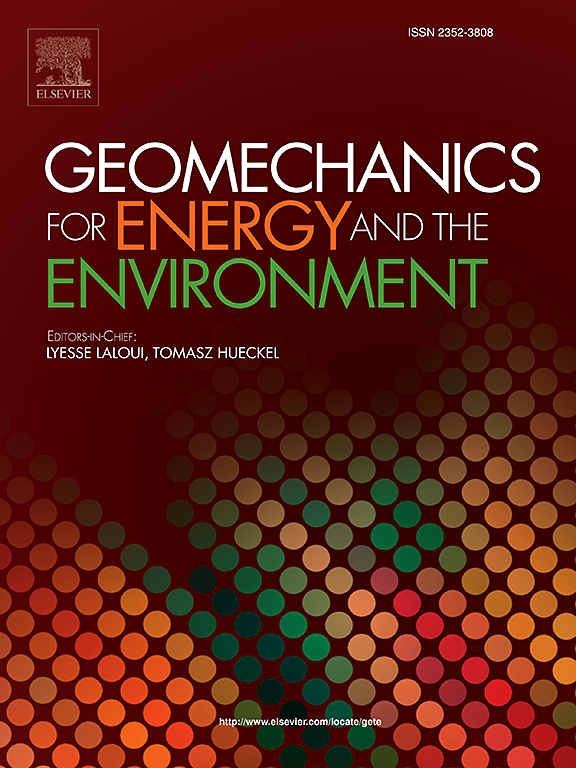Discontinuum-based numerical analysis of thermoshearing in planar and rough granite fractures: A comparison with laboratory observations
IF 3.3
2区 工程技术
Q3 ENERGY & FUELS
引用次数: 0
Abstract
In deep geological repositories (DGRs), decay heat from spent nuclear fuel raises the temperature, causing thermal stress and shear slip in pre-existing fractures in crystalline rocks, a phenomenon known as thermoshearing. An in-depth understanding of the thermoshearing mechanism in fractured rock masses is crucial for assessing the safety and stability of DGRs, as irreversible increase in permeability due to fracture shear slip can elevate fluid flow containing radionuclides and can compromise the integrity and performance of engineered barrier systems. This study presents a numerical reproduction of the laboratory thermoshearing experiments conducted on granite samples with planar and rough fractures using the three-dimensional discontinuum-based coupled code, TOUGH-3DEC. The calculated and measured temperatures at the heater and rock samples show reasonable agreement. The numerical models effectively capture the characteristic fracture shear behavior related to fracture roughness, as observed in the experiments. Irregular fracture roughness and relatively greater differential stress conditions applied in the rough fracture (RF) model induce shear slip before heating, differentiating the initiation timing of shear slip in the planar fracture (PF) and RF models. After heating, the maximum shear displacements for the PF and RF models are 68 μm and 74 μm, respectively, occurring near the top and bottom boundaries, where the temperature increase is the greatest. Among the five locations analyzed by digital image correlation, the largest shear displacement but the smallest dilation occurs at a specific location, indicating that intensified stress concentration at local protruding contacts can restrain the fracture dilation. The seismic events calculated using the developed seismic analysis algorithm show similarities with the measured acoustic emission events in terms of relative size and temporal distributions.
平面和粗糙花岗岩裂缝中基于不连续面的热剪切数值分析:与实验室观测的比较
在深部地质储存库(DGRs)中,乏核燃料的衰变热提高了温度,导致结晶岩石先前存在的裂缝产生热应力和剪切滑移,这种现象被称为热剪切。深入了解裂隙岩体的热剪切机制对于评估dgr的安全性和稳定性至关重要,因为裂缝剪切滑移导致的渗透率不可逆增加会提高含放射性核素的流体流动,并可能损害工程屏障系统的完整性和性能。本研究采用三维非连续介质耦合程序tough3dec,对具有平面和粗糙裂缝的花岗岩样品进行了室内热剪切实验,并进行了数值再现。加热器温度与岩样温度的计算值和实测值吻合较好。数值模型有效地捕捉了实验中观察到的与断裂粗糙度相关的特征断裂剪切行为。粗糙断裂(RF)模型中不规则的裂缝粗糙度和相对较大的差应力条件在加热前诱发剪切滑移,区分了平面断裂(PF)和粗糙断裂(RF)模型中剪切滑移的起始时间。加热后,PF和RF模型的最大剪切位移分别为68 μm和74 μm,发生在温度升高最大的顶部和底部边界附近。在数字图像相关分析的5个位置中,某一特定位置剪切位移最大,而剪胀最小,说明局部突出接触处应力集中加剧可以抑制断裂的剪胀。利用开发的地震分析算法计算的地震事件在相对大小和时间分布方面与实测声发射事件相似。
本文章由计算机程序翻译,如有差异,请以英文原文为准。
求助全文
约1分钟内获得全文
求助全文
来源期刊

Geomechanics for Energy and the Environment
Earth and Planetary Sciences-Geotechnical Engineering and Engineering Geology
CiteScore
5.90
自引率
11.80%
发文量
87
期刊介绍:
The aim of the Journal is to publish research results of the highest quality and of lasting importance on the subject of geomechanics, with the focus on applications to geological energy production and storage, and the interaction of soils and rocks with the natural and engineered environment. Special attention is given to concepts and developments of new energy geotechnologies that comprise intrinsic mechanisms protecting the environment against a potential engineering induced damage, hence warranting sustainable usage of energy resources.
The scope of the journal is broad, including fundamental concepts in geomechanics and mechanics of porous media, the experiments and analysis of novel phenomena and applications. Of special interest are issues resulting from coupling of particular physics, chemistry and biology of external forcings, as well as of pore fluid/gas and minerals to the solid mechanics of the medium skeleton and pore fluid mechanics. The multi-scale and inter-scale interactions between the phenomena and the behavior representations are also of particular interest. Contributions to general theoretical approach to these issues, but of potential reference to geomechanics in its context of energy and the environment are also most welcome.
 求助内容:
求助内容: 应助结果提醒方式:
应助结果提醒方式:


